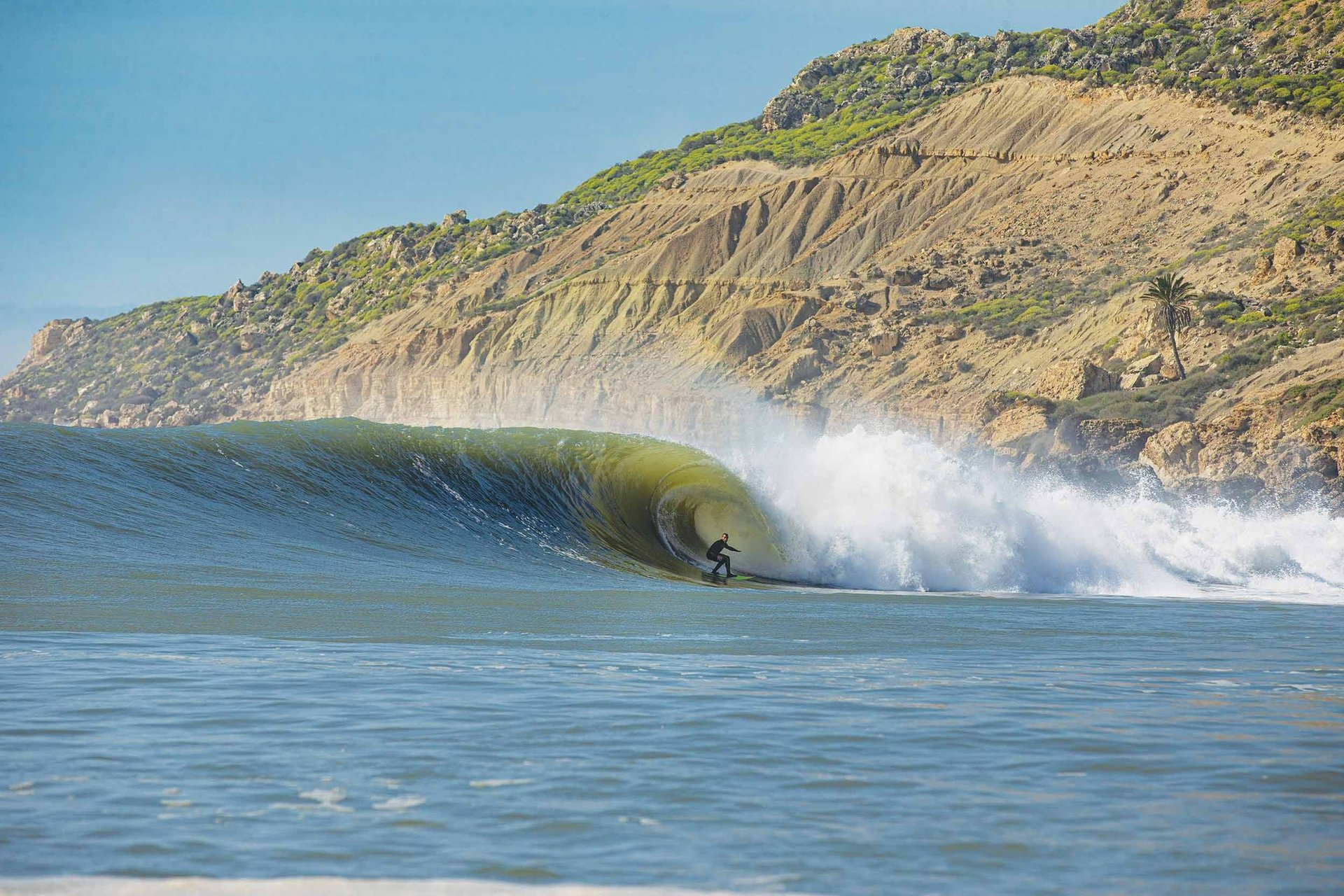
Top 5 Surf Destinations From November to February
Planning a surf trip from November to February? From Morocco’s right-hand points to North Peru’s endless lefts, we break down the 5 best winter surf destinations, with zones, seasons, costs, and travel tips for real surf travelers.
Top 5 Surf Destinations for November to February: The Ultimate Guide for Surf Travelers
When the North Atlantic wakes up and most people are booking ski trips, surfers start quietly scanning charts and flight prices. A surf trip November–February can be the best move you make all year – if you choose the right corner of the map.
This is the Wave Riders TV breakdown of the 5 best winter surf destinations based on real swell windows, wind patterns, travel practicality and what the lineups have actually been doing the last seasons – not brochure fantasy.
We’ll go from tropical reefs in the Philippines and Barbados to North Atlantic islands, Peruvian desert lefts and the winter-machine that is Morocco.
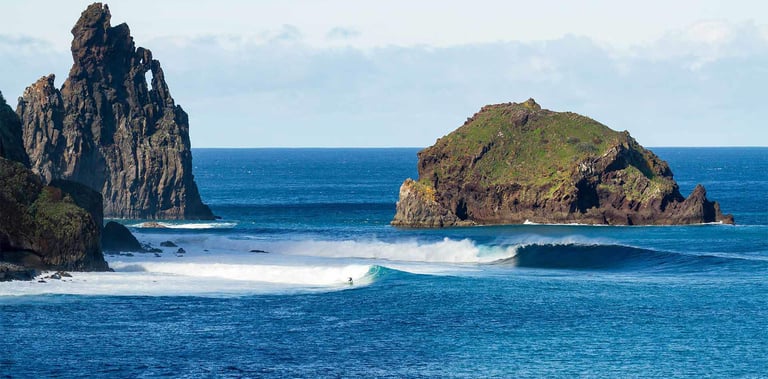

5. Philippines – Typhoon Hangovers and Monsoon Windows
The Philippines is not just “Siargao = Cloud 9”. It’s a massive archipelago with different coasts lighting up under different monsoons and North Pacific swells. For a surf trip November–February, you’re basically chasing:
Late typhoon season + North Pacific energy hitting Siargao and the east-facing islands.
Northeast monsoon swell showing up on Luzon’s east and northwest coasts (La Union, Baler, Pagudpud).
Why November–February works
Siargao (Mindanao, east-facing): Peak surf season is roughly September–May, with the best, most consistent barrels from November to February – bigger, cleaner North Pacific swell and generally favorable winds in the mornings.
Baler (Aurora, east Luzon): Prime time is October–April, when NE monsoon swell wraps into Sabang Beach and nearby points.
La Union (NW Luzon): NE monsoon pushes swell into San Juan and nearby reefs roughly November–March.
Pagudpud (far north Luzon): Catches similar NE monsoon and North Pacific energy as La Union, with less infrastructure but more “edge of the map” feeling.
Key Surf Zones & Wave Types
Siargao – Cloud 9 & surrounds
Wave type: Mostly sharp reef – heavy, hollow rights and lefts, with Cloud 9 the poster child: a ledgy right over shallow reef, barrels on take-off.
Size Nov–Feb: Often head-high to double-overhead on the main reef passes when the North Pacific is active.
Level: Intermediate on smaller days at the user-friendly reefs; advanced at Cloud 9 and heavier spots.
Crowd: Very crowded at Cloud 9 in season, less so on outer reefs and boat-access spots.
La Union (San Juan & area)
Wave type: Beachbreaks and some reefs/points, great for learners and intermediates. Sabang-style “foamie” sessions here are in Baler, but La Union has similar forgiving setups.
Size Nov–Feb: Waist–overhead depending on monsoon strength.
Level: Beginner–intermediate.
Crowd: Growing quickly – weekends feel like a city beach, weekdays more relaxed.
Baler (Sabang & nearby)
Wave type: Long beachbreak at Sabang for learners, with more powerful points/reefs a little further out of town.
Level: True all-level zone depending on which corner you surf.
Pagudpud
Wave type: Variety of reefs and beachbreaks, less documented and more exploratory.
Level: Intermediate+ if you go hunting outside the obvious spots.
Travel Practices – Philippines
Best entry airports: Manila (MNL) is the main hub; from there you connect to Siargao (IAO), Cebu (CEB) or regional airports (Laoag for Pagudpud, Clark/Manila for La Union & Baler).
Costs:
Domestic flights can be cheap if booked early.
Food and local stays are generally budget to mid-range.
Getting around:
Trains and buses Luzon-side (La Union, Baler).
Scooters and tricycles almost everywhere.
In Siargao, everyone ends up on a scooter eventually.
Accommodation: From surf hostels and homestays to boutique villas around Siargao.
Culture notes: Super friendly, English widely spoken, nightlife growing in Siargao and La Union.
Things to know: Typhoons can still affect weather early in November; always check forecasts and travel advisories.
Who it’s for (Philippines)
Beginners: La Union, Baler, mellow days in Siargao.
Intermediates: Siargao’s friendlier reefs, La Union more advanced banks, Baler points.
Advanced: Cloud 9 and heavier Siargao slabs; more exposed reefs around Luzon.

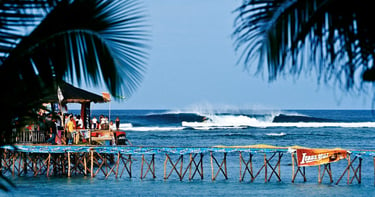


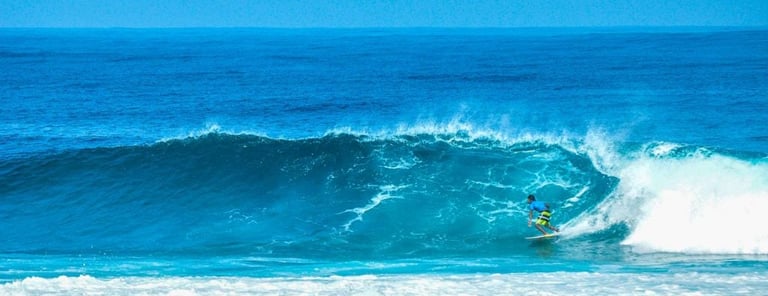

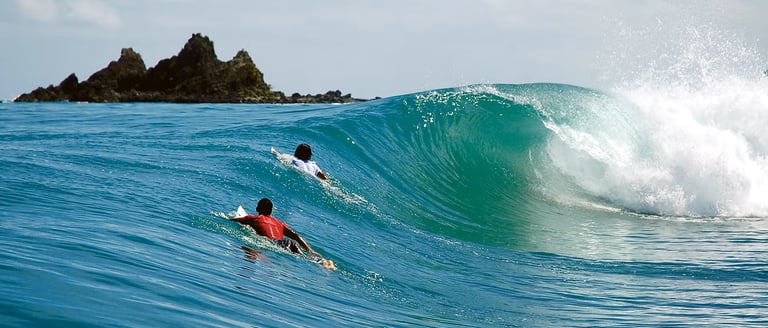



4. Barbados – Trade-Wind Playground in the Atlantic
If you want a winter escape that feels like a surf trip and a holiday at the same time, Barbados is a very good call. It’s warm, easy, English-speaking and surprisingly consistent from late October through March, with peak season November–March thanks to North Atlantic winter storms.
Why November–February works
Swell source: North Atlantic winter storms send NE–N swells that wrap into the island, especially on the east coast.
Winds: Consistent NE trade winds; east coast is often onshore with off shore windows, but wind + reef shape still create heavy, rippable waves
East and West Coasts – How They Surf
Soup Bowl & friends (East)
Wave type: Heavy, powerful reefbreaks. Soup Bowl at Bathsheba is the star – a world-class right that can serve draining barrels and big walls in winter.
Size Nov–Feb: Often head-high to well overhead when the North Atlantic is pumping.
Level: Advanced when big; intermediates can pick smaller days/shoulder sections.
Crowd: Can be busy with locals and visiting pros when it’s firing, but still way calmer than other famous reefs.
West Coast
Wave type: When a huge N–NE swell wraps around, west coast reefs turn on – cleaner faces, often with lighter winds.
Level: Intermediate–advanced depending on size.
Vibe: Surf in the morning, swim/snorkel in turquoise water by lunch. This is the “Caribbean postcard” side.
Travel Practices – Barbados
Airport: Grantley Adams International (BGI). Easy in and out from Europe and North America.
Costs:
Not ultra-cheap, but manageable: mid–high range for stays, food and car rentals.
You can still do it on a budget with apartments and local food spots.
Getting around:
Island is small; rental cars or taxis work fine.
Accommodation: Guesthouses in Bathsheba, apartments along south/west coasts, boutique hotels and villas.
Culture notes: Super friendly island, no language barrier (English), strong local surf community.
Who it’s for (Barbados)
Intermediates: South/west coast reefs and mellower east coast days.
Advanced: Soup Bowl and heavier east/north setups in peak winter.
Non-surf partners: Ideal – beaches, food, rum, snorkeling, everything is easy.
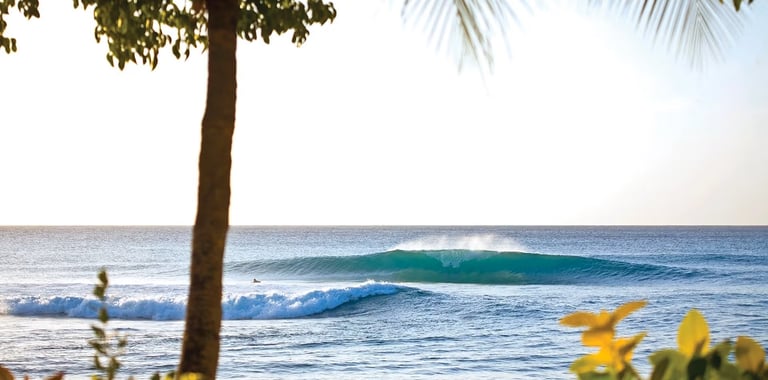




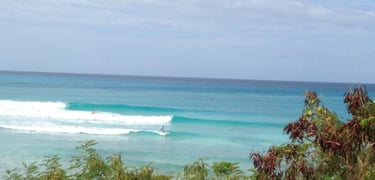
3. Europe – Canary Islands, Azores, Madeira, Peniche, País Vasco, Hossegor
If you don’t want to sit out winter in Europe, you basically have two plays for a surf trip November–February:
Chase warmer water and consistent swell in the Atlantic islands.
Embrace cold and heavy beachbreaks/points on the continental coast.
Why November–February works
Canary Islands: Often called “the European Hawaii” for a reason – powerful Atlantic groundswell and relatively warm water in winter, with reef setups across multiple islands.
Azores: Smack in the North Atlantic storm path, with strong N–NW swells from October–March.
Madeira: Winter is prime; December–January get the full brunt of strong NW swells that light up right-hand points like Jardim do Mar.
Peniche (Portugal): Autumn is the most user-friendly, but winter brings heavier swells and more advanced conditions, especially at Supertubos.
País Vasco & Hossegor: Winter is peak swell time – consistent Atlantic storms send heavy surf into the Bay of Biscay; protected corners like Mundaka and some Basque reefs come alive, while Hossegor’s beachbreaks get serious.
Canary Islands
Wave type: Lava reefs, some sand/reef mixes and a few friendlier beaches; everything from mellow walls to shallow slabs.
Wind & swell: Big NW–W swells, north/east trades; mornings often calmest. Winter is very reliable.
Level: Intermediate–advanced overall, but there are beginner beaches (Famara, Las Canteras, etc.).
Crowd vibe: Can be localized at some reefs, mellow at surf-camp zones; respect is key.
Azores & Madeira
Wave type: Heavier Atlantic reef/point setups, especially on north coasts; some more sheltered, user-friendly zones south-side.
Level: Mostly intermediate–advanced; not ideal as your first surf trip.
Vibe: Wild, dramatic scenery, often small crowds; more “mission-surfer” than surf-camp party.
Peniche, País Vasco, Hossegor
Peniche (Supertubos, Baleal):
Sand-bottom beachbreaks and points.
Winter = heavier, colder, more advanced, with Supertubos serving legit barrels on big NW swells.
País Vasco (Spain/France):
Spanish side: Mundaka, Zarautz and a line of reefs/beaches that really turn on in winter.
French side (Hossegor & Landes): very powerful beachbreaks; autumn is friendlier, winter can be huge and stormy but offers magical windows.
Travel Practices – Europe
Airports:
Canaries: Tenerife (TFS/TFN), Gran Canaria (LPA), Lanzarote (ACE), Fuerteventura (FUE).
Azores: Mainly Ponta Delgada (PDL).
Madeira: Funchal (FNC).
Peniche: via Lisbon (LIS).
País Vasco & Hossegor: Bilbao (BIO), Biarritz (BIQ), San Sebastián (EAS) or even Bordeaux (BOD).
Costs:
Canaries, Peniche: still relatively affordable (low-cost flights, mid-range stays).
Azores/Madeira: slightly pricier logistics, but not insane.
Transport: Renting a car is almost mandatory in islands and Peniche; trains/buses help along the mainland coast but aren’t perfect with boards.
Who it’s for (Europe winter)
Beginners: Only in the more sheltered/beginner-focused spots (Canary surf camps, some Portuguese beaches).
Intermediates: Canary Islands’ user-friendly reefs, Peniche on smaller winter days.
Advanced: Azores, Madeira, Hossegor in winter, Mundaka, heavy Canarian slabs.




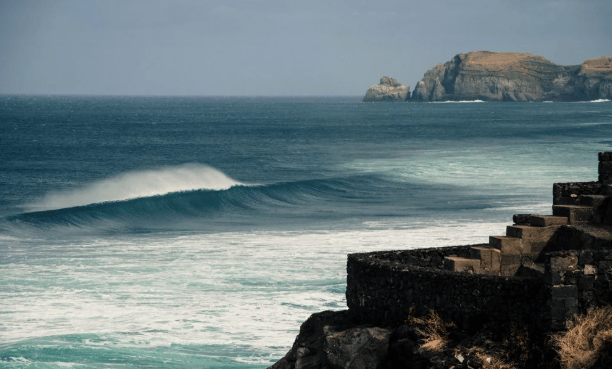

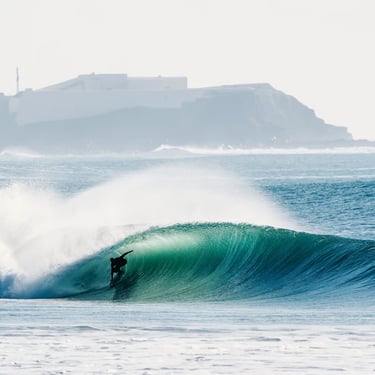

2. North Peru – Desert Lefts & "Warm-Water" North Swells
North Peru in November–February is a different kind of winter surf trip: warmer water compared the rest of the year, dry desert landscapes, empty highways and a coastline stacked with long left-hand pointbreaks. This is the season when North Pacific swells start wrapping into the points, lighting up the heavier and rarer waves of the region — especially Cabo Blanco and Panic Point.
Why November–February Works
North Pacific swells hit the Peruvian coastline.
Warmest water of the year up north.
Classic lefts like Cabo Blanco and Panic Point only break properly in this window.
Lobitos, Máncora and Negritos stay consistent with fun walls and long rides.
Key Zones – Lobitos, Cabo Blanco, Máncora, Negritos
Lobitos
Wave type: Multiple left points/reefs stacked along a short coast – Baterías, Lobitos, El Hueco etc. Long, rippable lefts, with more hollow sections on lower tides.
Level: Intermediate–advanced; beginners can find soft sections on small days.
Crowd: Increasing but still mellow compared to other world-class zones; plenty of peaks helps.
Cabo Blanco
Wave type: Heavy, barreling left over shallow reef, short but powerful.
Season Nov–Mar: Only really comes alive in this North swell window, often with serious power – this is not a learner wave.
Level: Advanced only.
Panic Point
One of the heaviest and most technical waves in Peru.
Only breaks with solid north swell + right tide/sand.
Level: Experts — fast, shallow, unpredictable.
Máncora
Wave type: Long left over reef, more forgiving than Cabo Blanco or the heavier Lobitos sections; very popular with longboarders and progressing intermediates.
Travel Practices – North Peru
Airports:
Lima (LIM) then connect to Piura (PIU) or Tumbes (TBP), followed by a few hours by road to Máncora/Lobitos region.
Costs:
Food and accommodation are still relatively budget–mid range compared to many “famous” surf zones.
Getting around: Buses, private transfers, moto-taxis in towns; distances between Lobitos–Máncora–Cabo Blanco are manageable by car or moto.
Accommodation: Surf camps, simple posadas, some nicer lodges in Máncora and around Cabo Blanco.
Culture notes: Desert coastline, fishing towns, super relaxed vibe. Nightlife can get lively around Máncora.
Who it’s for (North Peru)
Intermediates: Máncora, softer days in Lobitos and Negritos.
Advanced: Cabo Blanco, heavier sections of Lobitos, big south or north swell days.
Longboarders & twin lovers: You’ll be happy almost everywhere up here.



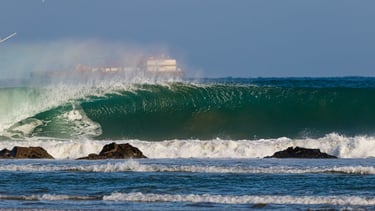
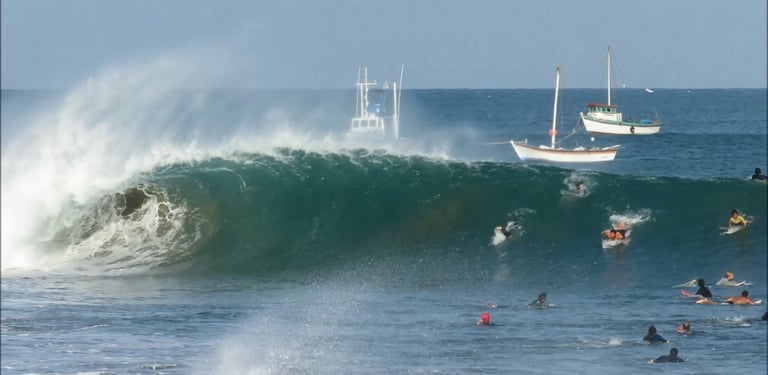

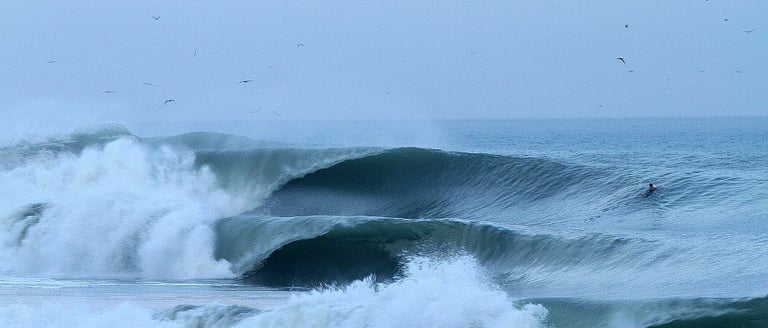

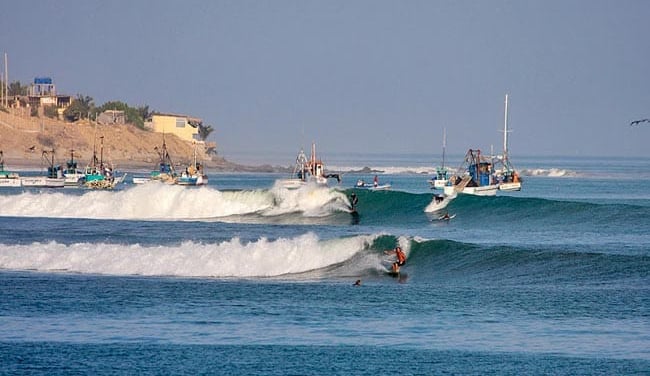

1. Morocco – Winter Pointbreak Heaven
If you had to choose just one destination for a surf trip between November and February, Morocco would be the safest bet. This is where powerful North Atlantic winter swells meet a coastline shaped almost perfectly for right-hand points.
From Agadir down to Sidi Ifni, and from Safi north toward Casablanca, the country has hundreds of reefs, coves and points. The core winter surf zone is around Taghazout, Tamraght and Imsouane, but the northern coast (Safi especially) becomes a completely different beast when big NW swells hit.
Why November–February Works
Peak North Atlantic swell season — consistent W–NW groundswells.
Dry, sunny weather; cool but not freezing water (3/2 or 4/3).
Points hold size extremely well and offer long, mechanical rights.
Reliability: few destinations worldwide offer so many surfable days in this window.
Key Zones;
Taghazout & Tamraght
Wave type: A chain of right-hand points and reefs – Anchor Point, Panorama, Hash Point, Banana Point and more. Everything from long, soft points to heavy, bowling rights over rock.
Size Nov–Feb: Consistent shoulder–overhead, with solid days well above that on bigger swells.
Level:
Intermediates can find softer walls at Banana, Devil’s Rock, etc.
Advanced surfers will hunt big days at Anchor and more exposed reefs.
Crowd: It gets busy – Morocco is no secret – but there are enough points and tides to dodge peak crowds if you’re motivated.
Imsouane
Wave type: Very long right-hand point (the Bay) that can offer rides of 200–500m on the right swell and tide – super forgiving, a dream for longboarders and progressing intermediates.
Level: All levels (outside of the heaviest peak days); the inside sections are perfect for people stepping down board size.
Vibe: Slow fishing village pace, “one-more-wave” syndrome guaranteed.
Agadir Area
Agadir is more of a city base, but:
Multiple beachbreaks and mixed sand/reef setups work when the points are too big or crowded.
Great infrastructure, markets, restaurants and easy access to the Taghazout–Imsouane corridor.
Travel Practices – Morocco
Airports:
Agadir (AGA) and Marrakech (RAK) are the main gateways for Taghazout/Tamraght/Imsouane.
Costs:
Still one of the best value winter surf trips globally:
Budget hostels to mid-range surf camps and guesthouses.
Food is affordable – tagines, fresh fish, street snacks.
Getting around:
Taxis, local buses, rental cars; many surf camps organize daily surf-guiding and transport to the best spot for the day.
Culture notes:
Predominantly Muslim country; be respectful with dress and behavior in villages.
Tea, tagines and sunsets on rooftops become part of your daily rhythm.
Hazards:
Rocky entries on many points – watch locals and time sets.
Crowds & occasional localism on the most famous points – normal surf etiquette goes a long way.
Who it’s for (Morocco)
Beginners: Beachbreaks and protected inside sections around Tamraght, Devil’s Rock, etc.
Intermediates: Endless fun on the smaller/medium days at Banana, Panorama, Imsouane Bay.
Advanced: Anchor, Killer Point, bigger days at more exposed reefs south and north of Taghazout.
Northern Coast – Safi & Beyond
North of Essaouira, the coastline becomes wilder, heavier and more mission-oriented.
Safi: One of the heaviest right-hand pointbreaks in the Atlantic when it turns on — fast, hollow, extremely technical and compared by many to a “Moroccan Backdoor.”
Level: Advanced/Expert only.Safi to Casablanca: A string of lesser-known reefs and points, many of them tide- and swell-sensitive.
Vibe: Less surf-camp atmosphere, more local, more raw — perfect for surfers who already know the Taghazout area and want to push deeper.
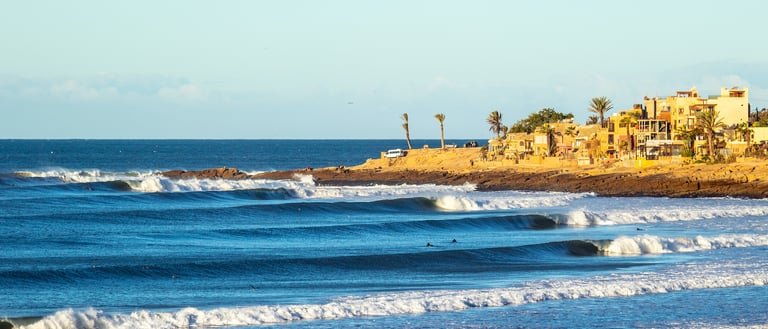


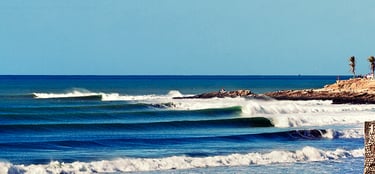
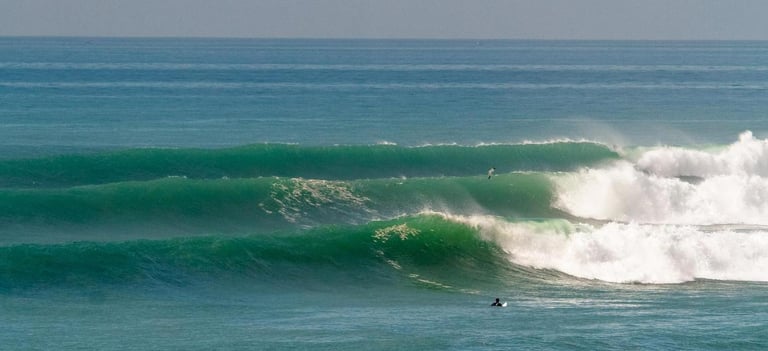

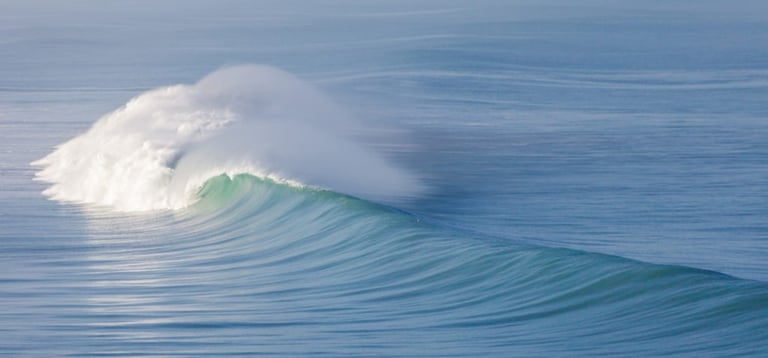



Final Thoughts – From One Surf Traveler to Another
If I had one shot at a winter surf trip and wanted the best mix of consistency, cost, and wave quality, I’d probably start with Morocco or North Peru. Morocco if I wanted right points, tagines and easy flights; North Peru if I wanted left points, desert lines and slower days.
If I had a bit more budget and wanted warm water + “holiday feel”, Barbados would be high on the list.
If I wanted to mix surf with a wider Euro adventure and didn’t mind neoprene, I’d look at Canaries + Peniche or País Vasco.
And if I wanted something a little more tropical and chaotic, where the surf and the party blur into one, I’d angle for Philippines – Siargao plus a Luzon side mission.
At the end of the day, the best winter surf destinations are the ones that match your level, your budget, and the kind of memories you want to stack. Lines on a map are just the start – the real trip begins when your board bag hits the conveyor belt and you walk out into warm or cold air in a place you’ve never been.
